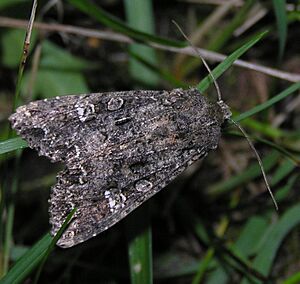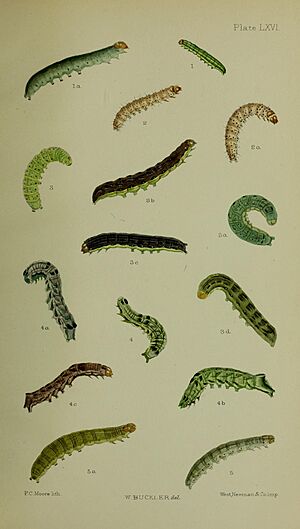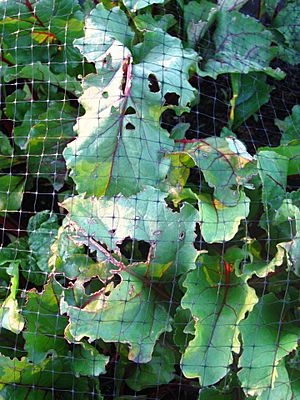Cabbage moth facts for kids
Quick facts for kids Cabbage moth |
|
|---|---|
 |
|
| Scientific classification |
The cabbage moth (Mamestra brassicae) is a type of moth that is often seen as a pest. It can cause a lot of damage to many different plants. Even though it's called the "cabbage moth," it eats more than just cabbage. It likes many fruits, vegetables, and other plants like broccoli, Brussels sprouts, tobacco, sunflowers, and tomatoes. This makes it a big problem for farmers.
These moths live in a very large area called the Palearctic region. This includes parts of Europe and Asia. Because they live in so many different places, cabbage moths have learned to adapt to their local environments. This means their life and behavior can be quite different depending on where they live.
Contents
Where Cabbage Moths Live
The cabbage moth is found across a wide area in Europe and Asia. This range stretches from about 30°N to 70°N latitude. This entire area is part of the Palearctic region. This region covers parts of Europe, Asia north of the Himalayan Mountains, and Africa north of the Sahara Desert. Many of the plants the moth eats grow naturally or are farmed in this region. This helps the moth to live successfully in almost all parts of this area.
Even though the moth usually stays within this region, there's a chance it could spread to new places. This could happen through global trade, especially when live plants are shipped around the world.
Cabbage Moth Family Tree
The cabbage moth, Mamestra brassicae, has a name that sounds like other insects. But it's important not to confuse it with the cabbage looper (Trichoplusia ni) or the white cabbage butterfly (Pieris rapae). These insects have similar names but are actually very different types of creatures.
The cabbage moth belongs to a large group called Lepidoptera. This group includes all moths and butterflies. Within this group, it's part of a smaller group called Ditrysia. This group includes 98% of all moth and butterfly species. It means that female moths in this group have two separate openings for mating and laying eggs. The cabbage moth is also part of the family Noctuidae. This is the second largest family in the Lepidoptera group. Inside this family, the cabbage moth is in the subfamily Hadeninae. The group of moths called Mamestra includes many pest species and is found all over the world.
Life Story of the Cabbage Moth
The life cycle of the cabbage moth can change a lot depending on where it lives. In some warmer places, a moth can go through two or even three full life cycles in one year. In colder places, they might only have one generation per year. A very flexible part of their life is called Diapause. This is like a resting period, often during winter. It can last from about 80 days to six months if needed.
Eggs
When a female moth lays her eggs, they are pale white and shaped like a half-sphere. They have ribs on them and a brown spot in the middle. Each egg is about 1.2 millimeters wide. The eggs usually hatch into caterpillars within six to ten days.
Caterpillars
Cabbage moth caterpillars go through six different growth stages, called instars. In the first stage, the caterpillar is light green. It has three pairs of legs near its head and a small tail-like part at the end of its body. The caterpillars stay mostly the same color until their fourth stage. Then, their back starts to get darker, turning brown. Their belly becomes yellow. Sometimes, their colors can vary a bit. A dark stripe appears down their back, with light yellow stripes on their sides. Their head is a copper color.
In their sixth and final stage, the head stays copper, and their body might develop a small hump on their back. It takes about four to six weeks for the caterpillar to grow. When fully grown, they are about 40 to 50 millimeters long.
Young caterpillars often eat together on plant leaves at night. They usually stay on the underside of leaves, close to the ground. As they get bigger, especially in the fourth stage, they might spread out to other parts of the same plant or even move to new plants. When they are ready to change into pupae, the caterpillars dig into the soil. They stay there until they become adult moths.
Pupae
The pupae (the stage between caterpillar and adult moth) are brown and shiny. Moths can become pupae once or twice a year. This stage often happens during the winter. The pupae develop inside cocoons that they make in the soil. They are usually about 20 millimeters long. You can find them buried in the ground, anywhere from 2 to 10 millimeters deep.
Adults
Adult moths come out of the soil in May and June. They look similar to many other moths in their family. They can be gray, black, green, or brown. They have delicate patterns of lines and spots all over their bodies. Their front wings are usually darker than their back wings. A special mark that helps identify them is a kidney-shaped spot on their front wing, outlined in white. There is also a thin white border around the entire front wing.
Their wingspan, from one wingtip to the other, is between 34 and 50 millimeters. The size of the adult moth depends on how much food it had when it was a caterpillar. They also have special curved spurs on the front legs that help tell them apart from similar moths.
Adult Moth Habits
Adult moths appear from late April to early June. Soon after they emerge, they mate. Cabbage moths are most active at night. They fly between plants and feed. During the day, adult moths hide under the leaves of nearby plants to stay safe.
Mating
Cabbage moths mate shortly after they become adults. In one study, adult moths started mating on the very first night they emerged.
Laying Eggs
Female moths lay their eggs one by one, but they often put many eggs close together on the same surface. A female can lay up to 350 eggs in a cluster on the underside of a leaf. After mating, a female might lay around 2500 eggs in total. Eggs are usually laid from May to June, but this can vary depending on the moth population. The eggs hatch in five to twelve days. How long it takes for eggs to hatch depends a lot on the temperature. For example, it takes about six days at 25°C but up to 12 days at cooler temperatures.
Scientists have studied how female moths choose where to lay their eggs. They compared three different plants: cabbage, tomatoes, and chrysanthemums. Females landed on tomato plants most often, but they spent the most time on cabbage plants. They also laid eggs faster on cabbage plants. They spent more time checking tomato leaves before laying eggs. This shows that cabbage plants are a favorite place for them to lay eggs. It also suggests that females check the quality of a plant before laying eggs. They laid very few eggs on chrysanthemums, showing they have plant preferences.
Another study looked at how damaged plants affect where female moths lay eggs. Surprisingly, female moths often choose damaged plants for laying eggs. This seems strange because you might think they would pick healthy plants. This would help their babies avoid competing for food with whatever caused the damage. However, scientists think that damaged plants release certain smells that attract the female moths.
Traveling Moths
A study in East Asia showed that cabbage moths can travel long distances. Researchers found that they migrate across a strait (a narrow body of water) that is 40 to 60 kilometers wide. The study also found that more females migrate than males. Many more females were caught during migration from May to September. These migrating females were also found to be ready for mating and had well-developed eggs. Scientists believe this migration helps female moths become ready to mate and lay eggs in their new homes.
A Farm Pest
Cabbage moth caterpillars cause the most damage when they are young, from their first to fourth stages. In their first three stages, the caterpillars eat together. They can eat so much that they leave only the "skeleton" of the leaves where they were laid. In the fourth stage, the caterpillars often dig into the center of fruits, vegetables, and other plants. This makes the plants impossible to sell. Also, the caterpillars leave their waste on the leaves. This can spread fungal and bacterial infections to the plant, making it even less valuable. Because of this serious damage, cabbage moths are considered pests. Farmers and others in agriculture try to control their numbers.
There are not many chemical ways to control these moths. However, one successful method is using certain types of wasps. These wasps are parasites that lay their eggs inside the cabbage moth eggs or pupae. When these wasps are introduced to fields, they can greatly increase the number of cabbage moths that are parasitized. This can reduce the moth population from just 15% to as much as 93%, which is a big help to farmers.
What Cabbage Moths Eat
Here is a list of plants that the cabbage moth is known to eat:
- Allium – onion
- Aquilegia – columbine
- Beta – beet
- Brassica (like cabbage, broccoli)
- Bryonia – bryony
- Calendula – marigold
- Chrysanthemum
- Cucurbita (like squash, pumpkin)
- Dianthus – carnation
- Helianthus – sunflower
- Hyoscyamus – henbane
- Hyssopus – hyssop
- Lactuca – lettuce
- Linum – flax
- Lychnis – Maltese cross
- Lycopersicon – tomato
- Malus – apple
- Nicotiana – tobacco
- Pisum – pea
- Plantago – plantain
- Raphanus – radish
- Rheum – rhubarb
- Rudbeckia
- Rumex (like dock, sorrel)
- Silene
- Solanum – potato
- Spinacia – spinach





